2009 Hyundai Accent cooling
[x] Cancel search: coolingPage 12 of 232
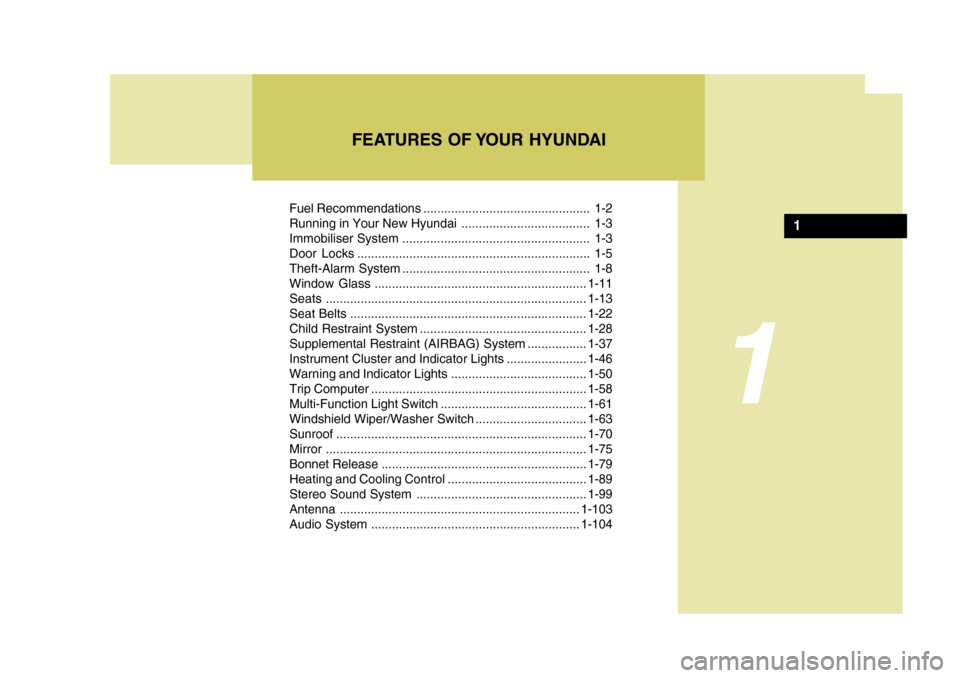
FEATURES OF YOUR HYUNDAI
1
1
Fuel Recommendations ................................................ 1-2
Running in Your New Hyundai ..................................... 1-3
Immobiliser System ...................................................... 1-3
Door Locks ................................................................... 1-5
Theft-Alarm System ...................................................... 1-8Window Glass............................................................. 1-11
Seats ........................................................................... 1-13
Seat Belts .................................................................... 1-22
Child Restraint System ................................................ 1-28
Supplemental Restraint (AIRBAG) System .................1-37
Instrument Cluster and Indicator Lights .......................1-46
Warning and Indicator Lights....................................... 1-50
Trip Computer .............................................................. 1-58
Multi-Function Light Sw itch .......................................... 1-61
Windshield Wiper/Washer Switch ................................1-63
Sunroof ........................................................................ 1-70
Mirror ........................................................................... 1-75
Bonnet Release ........................................................... 1-79
Heating and Cooling Control .......... ..............................1-89
Stereo Sound System ................................................. 1-99
Antenna ..................................................................... 1-103
Audio System ............................................................ 1-104
Page 64 of 232
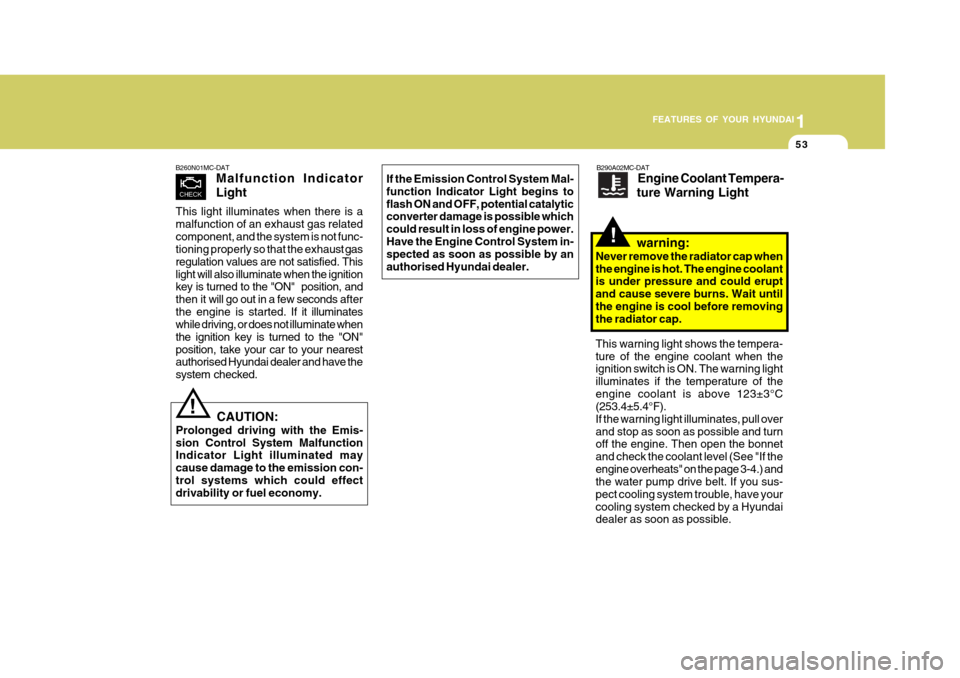
1
FEATURES OF YOUR HYUNDAI
53
If the Emission Control System Mal- function Indicator Light begins toflash ON and OFF, potential catalytic converter damage is possible which could result in loss of engine power.Have the Engine Control System in- spected as soon as possible by an authorised Hyundai dealer.
B260N01MC-DAT Malfunction Indicator Light
This light illuminates when there is a malfunction of an exhaust gas relatedcomponent, and the system is not func- tioning properly so that the exha ust gas
regulation values are not satisfied. This light will also illuminate when the ignition
key is turned to the "ON" position, and then it will go out in a few seconds after
the engine is started. If it illuminates
while driving, or does not illuminate whenthe ignition key is turned to the "ON"position, take your car to your nearest
authorised Hyundai dealer and have the system checked.
CAUTION:
Prolonged driving with the Emis- sion Control System Malfunction Indicator Light illuminated may cause damage to the emission con-trol systems which could effect drivability or fuel economy.!
B290A02MC-DAT Engine Coolant Tempera-
ture Warning Light
warning:
Never remove the radiator cap when the engine is hot. The engine coolant is under pressure and could erupt and cause severe burns. Wait untilthe engine is cool before removing the radiator cap.
!
This warning light shows the tempera- ture of the engine coolant when the ignition switch is ON. The warning light illuminates if the temperature of theengine coolant is above 123±3°C (253.4±5.4°F). If the warning light illuminates, pull overand stop as soon as possible and turn off the engine. Then open the bonnet and check the coolant level (See "If theengine overheats" on the page 3-4.) and the water pump drive belt. If you sus- pect cooling system trouble, have yourcooling system checked by a Hyundai dealer as soon as possible.
Page 100 of 232
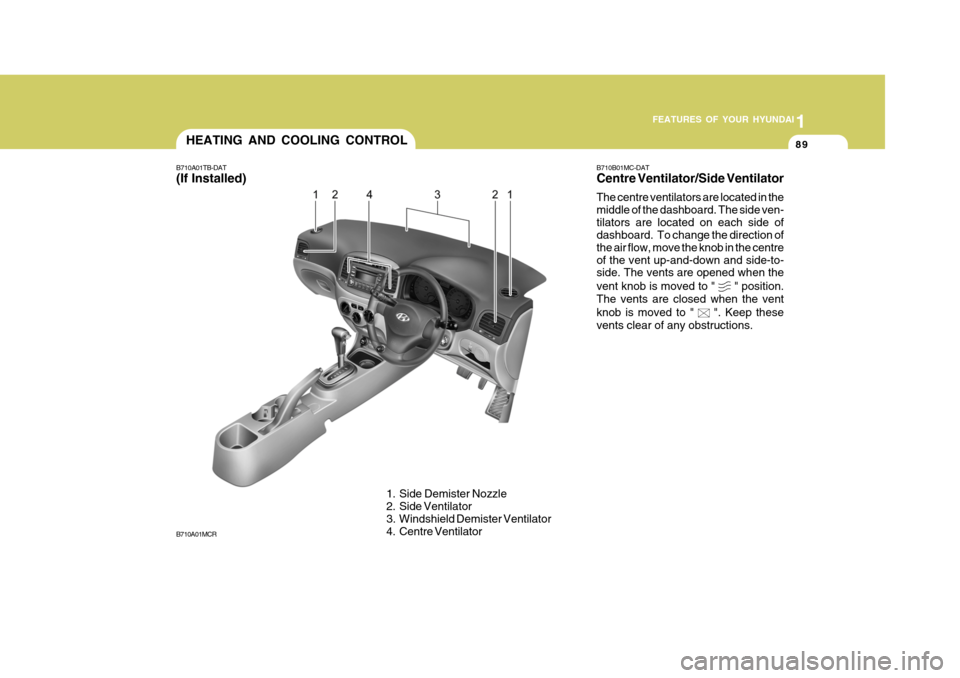
1
FEATURES OF YOUR HYUNDAI
89HEATING AND COOLING CONTROL
B710A01TB-DAT (If Installed)
1. Side Demister Nozzle
2. Side Ventilator
3. Windshield Demister Ventilator
4. Centre Ventilator
B710A01MCR B710B01MC-DAT Centre Ventilator/Side Ventilator The centre ventilators are located in the middle of the dashboard. The side ven-tilators are located on each side of dashboard. To change the direction of the air flow, move the knob in the centreof the vent up-and-down and side-to- side. The vents are opened when the vent knob is moved to "
" position.
The vents are closed when the vent knob is moved to "
". Keep these
vents clear of any obstructions.
Page 104 of 232
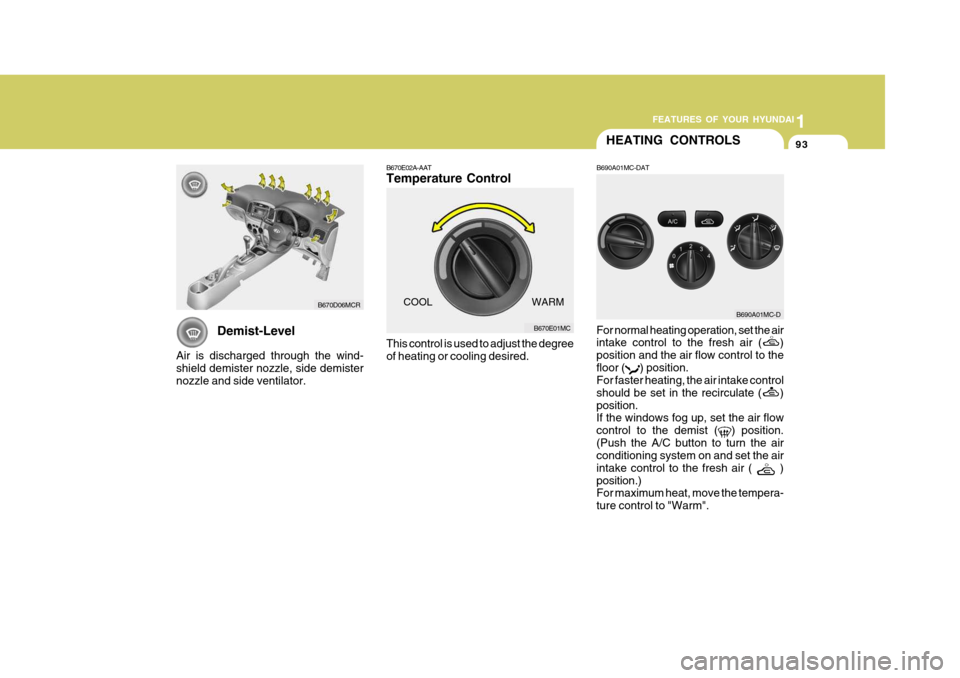
1
FEATURES OF YOUR HYUNDAI
93HEATING CONTROLS
For normal heating operation, set the air intake control to the fresh air (
)
position and the air flow control to the floor (
) position.
For faster heating, the air intake control should be set in the recirculate (
)
position. If the windows fog up, set the air flow control to the demist (
) position.
(Push the A/C button to turn the air conditioning system on and set the air intake control to the fresh air (
)
position.) For maximum heat, move the tempera- ture control to "Warm". B690A01MC-DAT
B670E02A-AAT Temperature Control This control is used to adjust the degree of heating or cooling desired.
Demist-Level
Air is discharged through the wind- shield demister nozzle, side demister nozzle and side ventilator.
B670D06MCR
B670E01MC
B690A01MC-D
COOL WARM
Page 106 of 232

1
FEATURES OF YOUR HYUNDAI
95
To remove the frost or exterior fog on the windshield:
o Set the air flow control to the demist
(
) position. (Push the A/C button
to turn the air conditioning system on and set the air intake control to the fresh air (
) position.)
o Set the temperature control to warm.
o Set the fan speed control to position "3" or "4".
B720A02MC-D B730A01L-AAT Operation Tips
o To keep dust or unpleasant fumes
from entering the car through the ventilation system, temporarily set the air intake control at the (
)
position. Be sure to return the control to the (
) position when the irrita-
tion has passed to keep fresh air in the vehicle. This will help keep thedriver alert and comfortable.
o Air for the heating/cooling system is
drawn in through the grilles just aheadof the windshield. Care should be taken that these are not blocked by leaves, snow, ice or other obstruc-tions.
o To prevent interior fog on the wind-
shield, set the air intake control tothe fresh air (
) position, fan speed
to the desired position, turn on the air conditioning system, and adjust tem-perature control to desired tempera- ture.
NOTE: When the A/C is operated continu- ously on the floor-demist level (
)
or demist level (
), it may cause fog
to form on the exterior windshield. If this occurs, set the air flow control to the face level position (
) and fan
speed control to the low position.
Page 107 of 232
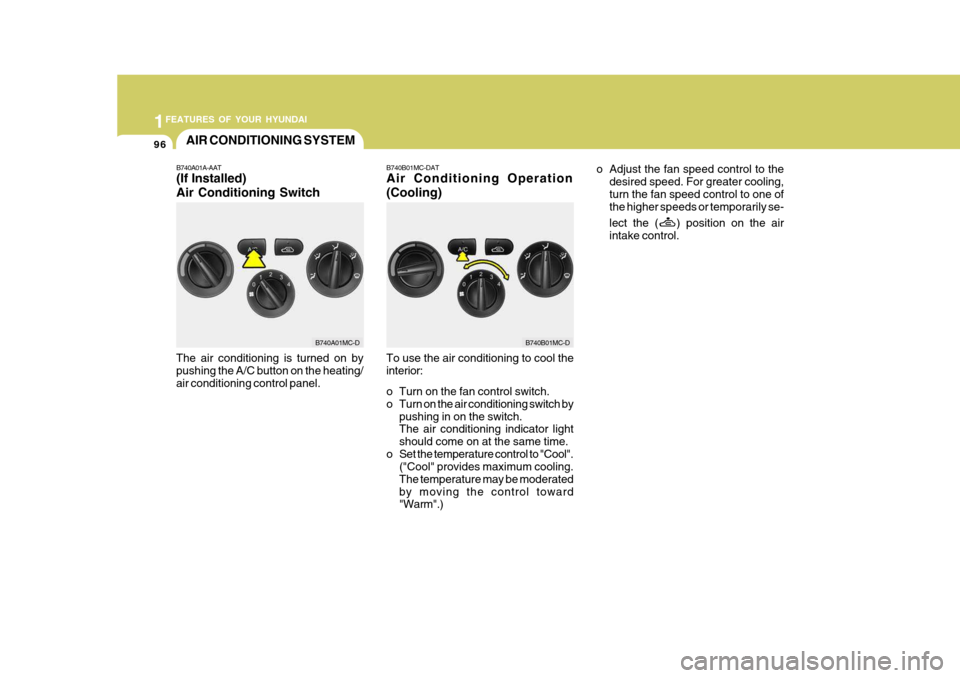
1FEATURES OF YOUR HYUNDAI
96
B740B01MC-DAT Air Conditioning Operation (Cooling) To use the air conditioning to cool the interior:
o Turn on the fan control switch.
o Turn on the air conditioning switch by
pushing in on the switch. The air conditioning indicator light should come on at the same time.
o Set the temperature control to "Cool". ("Cool" provides maximum cooling.The temperature may be moderatedby moving the control toward "Warm".) o Adjust the fan speed control to the
desired speed. For greater cooling, turn the fan speed control to one of the higher speeds or temporarily se- lect the (
) position on the air
intake control.
B740B01MC-D
AIR CONDITIONING SYSTEM
B740A01A-AAT (If Installed) Air Conditioning Switch
The air conditioning is turned on by pushing the A/C button on the heating/ air conditioning control panel.
B740A01MC-D
Page 146 of 232

2
DRIVING YOUR HYUNDAI
19
2
DRIVING YOUR HYUNDAI
19
C160C01A-AAT Use High Quality Ethylene Gly- col Coolant Your Hyundai is delivered with high quality ethylene glycol coolant in the cooling system. It is the only type ofcoolant that should be used because it helps prevent corrosion in the cooling system, lubricates the water pump andprevents freezing. Be sure to replace or replenish your coolant in accor- dance with the maintenance schedulein Section 5. Before winter, have your coolant tested to assure that its freez- ing point is sufficient for the tempera-tures anticipated during the winter.
It should be noted that installing tyrechains on the tyre will provide a greaterdriving force, but will not prevent side skids. NOTE: Tyre chains are not legal in all states. Check state laws before fitting tyrechains.WINTER DRIVING
C160B01A-DAT Snowy or Icy Conditions To drive your vehicle in deep snow, it may be necessary to use snow tyres or to install tyre chains on your tyres. If snow tyre are needed, it is necessaryto select tyres equivalent in size and type to the original equipment tyres. Failure to do so may adversely affectthe safety and handling of your car. Furthermore, speeding, rapid accel- eration, sudden brake applications, andsharp turns are potentially very haz- ardous practices. During deceleration, use engine brak-ing to the fullest extent. Sudden brake applications on snowy or icy roads may cause skids to occur. You need to
keep sufficient distance between the vehicle in operation in front and your vehicle. Also, apply the brake gently.
C160A01A-DAT The more severe weather conditions of winter result in greater wear and other problems. To minimise the prob- lems of winter driving, you should fol-low these suggestions:
C160F02A-AAT Check Spark Plugs and Ignition System Inspect your spark plugs and replace them if necessary. Also check allignition wiring and components to be sure they are not cracked, worn or damaged in any way.
C160E01A-AAT Change to "Winter Weight" Oil if Necessary In some climates it is recommended that a lower viscosity "winter weight" oil be used during cold weather. See Section 9 for recommendations. If youaren't sure what weight oil you should use, consult your Hyundai dealer.
C160D01A-DAT Check Battery and Cables Winter puts additional burdens on the battery and charging system. Visuallyinspect the battery and cables as de- scribed in Section 6. The level of charge in your battery can be checked by yourHyundai dealer or a service station.
Page 156 of 232
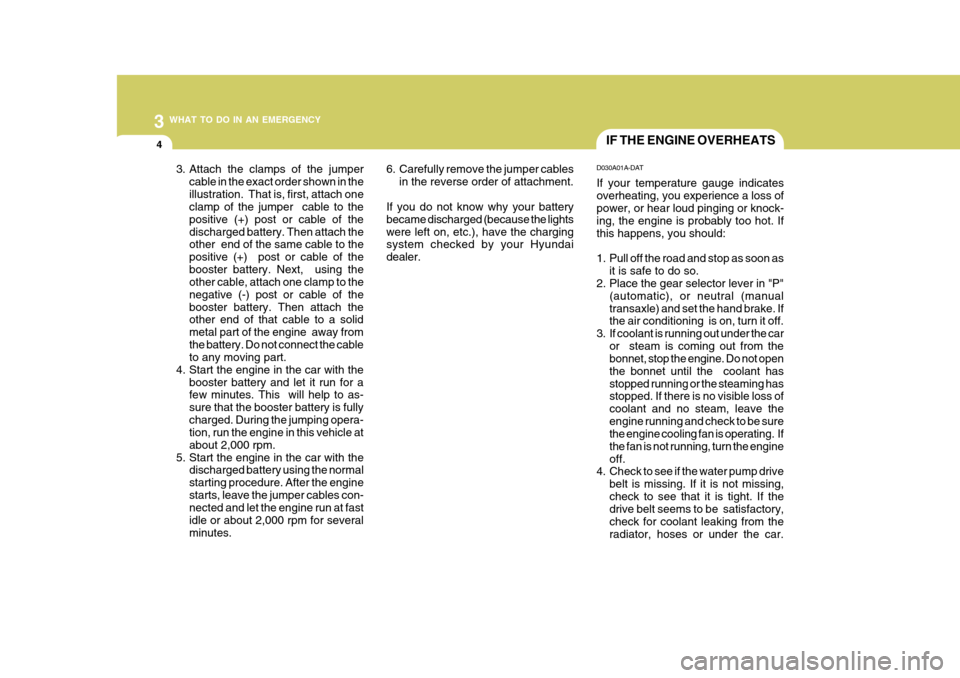
3 WHAT TO DO IN AN EMERGENCY
4IF THE ENGINE OVERHEATS
D030A01A-DAT If your temperature gauge indicates overheating, you experience a loss of power, or hear loud pinging or knock- ing, the engine is probably too hot. Ifthis happens, you should:
1. Pull off the road and stop as soon as it is safe to do so.
2. Place the gear selector lever in "P"
(automatic), or neutral (manual transaxle) and set the hand brake. If the air conditioning is on, turn it off.
3. If coolant is running out under the car or steam is coming out from thebonnet, stop the engine. Do not open the bonnet until the coolant hasstopped running or the steaming has stopped. If there is no visible loss of coolant and no steam, leave theengine running and check to be sure the engine cooling fan is operating. If the fan is not running, turn the engineoff.
4. Check to see if the water pump drive
belt is missing. If it is not missing,check to see that it is tight. If the drive belt seems to be satisfactory, check for coolant leaking from theradiator, hoses or under the car.
6. Carefully remove the jumper cables
in the reverse order of attachment.
If you do not know why your batterybecame discharged (because the lightswere left on, etc.), have the charging system checked by your Hyundai dealer.
3. Attach the clamps of the jumper
cable in the exact order shown in theillustration. That is, first, attach one clamp of the jumper cable to the positive (+) post or cable of thedischarged battery. Then attach the other end of the same cable to the positive (+) post or cable of thebooster battery. Next, using the other cable, attach one clamp to the negative (-) post or cable of thebooster battery. Then attach the other end of that cable to a solid metal part of the engine away fromthe battery. Do not connect the cable to any moving part.
4. Start the engine in the car with the booster battery and let it run for afew minutes. This will help to as- sure that the booster battery is fullycharged. During the jumping opera- tion, run the engine in this vehicle at about 2,000 rpm.
5. Start the engine in the car with the discharged battery using the normalstarting procedure. After the enginestarts, leave the jumper cables con- nected and let the engine run at fast idle or about 2,000 rpm for severalminutes.